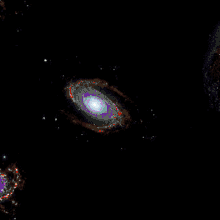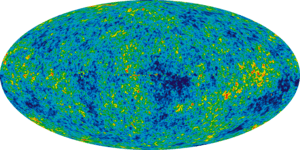Big Crunch
The Big Crunch is a hypothetical scenario for the ultimate fate of the universe, in which the expansion of the universe eventually reverses and the universe recollapses, ultimately causing the cosmic scale factor to reach zero, an event potentially followed by a reformation of the universe starting with another Big Bang. The vast majority of evidence indicates that this theory is not correct. Instead, astronomical observations show that the expansion of the universe is accelerating, rather than being slowed by gravity, suggesting that a Big Chill or Big Rip are far more likely to occur.

| Part of a series on | ||||
| Physical cosmology | ||||
|---|---|---|---|---|
 | ||||
|
Early universe
|
||||
|
Expansion · Future |
||||
|
Components · Structure
|
||||
| ||||
Overview
The Big Crunch scenario hypothesized that the density of matter throughout the universe is sufficiently high that gravitational attraction will overcome the expansion which began with the Big Bang. The FLRW cosmology can predict whether the expansion will eventually stop based on the average energy density, Hubble parameter, and cosmological constant. If the metric expansion stopped, then contraction will inevitably follow, accelerating as time passes and finishing the universe in a kind of gravitational collapse.
A more specific theory called "Big Bounce" proposes that the universe could collapse to the state where it began and then initiate another Big Bang, so in this way the universe would last forever, but would pass through phases of expansion (Big Bang) and contraction (Big Crunch).[1]
Experimental evidence in the late 1990s and early 2000s (namely the observation of distant supernovae as standard candles, and the well-resolved mapping of the cosmic microwave background)[2][3] led to the conclusion that the expansion of the universe is not being slowed by gravity but is instead accelerating. The 2011 Nobel Prize in Physics was awarded to researchers who contributed to making this discovery.[4]
However, Roger Penrose advances a general relativity based theory (called the conformal cyclic cosmology) in which the universe expands until all the matter decays and is turned to light. Since nothing in the universe would have any time or distance scale associated with it, it becomes identical with the Big Bang (resulting in a type of Big Crunch which becomes the next Big Bang, thus starting the next cycle).[5]
See also

- Arrow of time
- Bentley's paradox
- Big Rip, another model suggesting singularity at the Universe's end
- Chronology of the universe – Events since the Big Bang, 13.8 billion years ago
- Cyclic model
- Entropy (arrow of time)
- Eternal return – A theory that the universe and all existence is perpetually recurring
- Timeline of cosmological epochs
- Timeline of the far future – Scientific projections regarding the far future
References
- "Jennifer Bergman, The Big Crunch, Windows to the Universe (2003)". Archived from the original on 2010-03-16. Retrieved 2009-02-15.
- Wang, Yun; Kratochvil, Jan Michael; Linde, Andrei; Shmakova, Marina (2004). "Current observational constraints on cosmic doomsday". Journal of Cosmology and Astroparticle Physics. 2004 (12): 006. arXiv:astro-ph/0409264. Bibcode:2004JCAP...12..006W. doi:10.1088/1475-7516/2004/12/006.
- McSween, Stephen A. "Dark Energy and the Red Shift in a Contracting Universe."
- "The Nobel Prize in Physics 2011". nobelprize.org. Retrieved 2019-07-14.
- Penrose, Roger. "Cycles of Time: An Extraordinary New View of the Universe [Hardcover]." (2011).